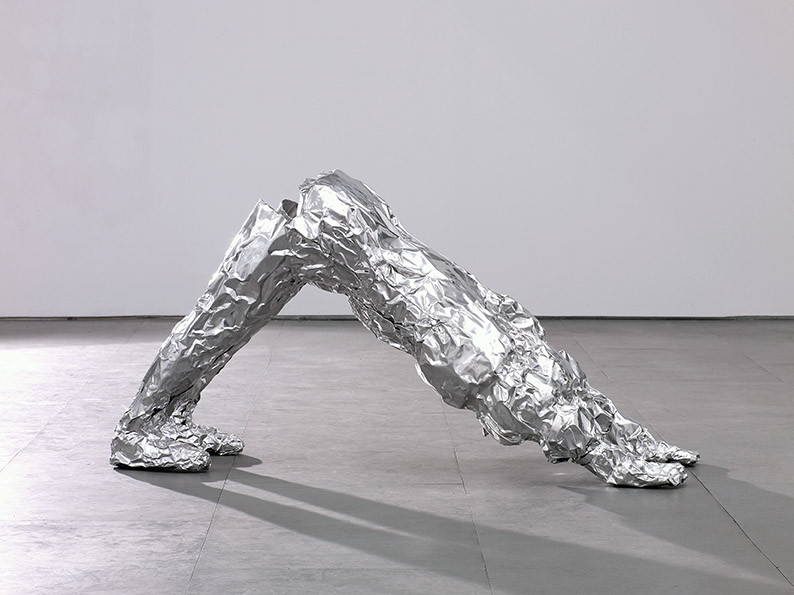Asta Gröting
18 Jan - 01 Mar 2014
ASTA GRÖTING
18 January – 1 March 2014
Freud told us that civic monuments and memorials are made to preserve the memory of a traumatic event (war, the loss of human life) and invite us to remember the painful experiences of the past. Gröting continues this conversation by sculpting monuments that preserve the memory of the present, or which ask questions of the present, while inviting us to speculate on a timeless absence- something or someone lost, missing, gone.
Space Between a Family was conceived when Gröting’s mother was fatally ill. It is an attempt to mourn in the present tense for a human subject, who, unlike the gentlemen in Bodenplatte 2, has not yet departed.
If it is a celebration and conservation of life, it is also an unsentimental gaze at family relations - the empty but haunted space of all that is unspoken between them. Gröting subverts the visual language we associate with most public monuments, always alert to the difficult task of casting abstract qualities such as thought, dignity, conflict, subjectivity. It is not hard to imagine that these introspective figures possess internal organs, (lungs, hearts, kidneys) but they are uncanny too, mournful grey ghosts of substance who seem to be emerging from both a war and a womb.
Yoga in Armor and Bodenplatte 2, playfully explore the ways in which monuments become social bodies - they are after all given to the world to gaze upon. If armor is a technology (or a metaphor) to protect us from danger, we all know that we are fragile beneath it. It is a strange fact then, that the armor that is supposed to make us feel stronger, also signals our vulnerability. No matter what kind of pose (standing like a warrior, standing on our heads) we might strike inside our armor - whether it be made of flesh or aluminium - we are all mortal and will eventually disappear.
Gröting is conceptually and emotionally asking questions of the social body by taking something away from it and allowing this absence to do the talking.
Deborah Levy*.
Asta Gröting lives and works in Berlin. 2014 her work will be part of the Cartagena Biennial in Bogotá, Colombia. Her work has been recently shown in following exhibitions: 2010 at NBK, Berlin (D) and Lentos Kunstmuseum, Linz (A), 2008 at Henry Moore Institute, Leeds (UK) and 2006 at MARTa Herford, Herford (D).
*Deborah Levy’s most recent novel „Heim schwimmen“ was shortlisted for the 2012 Man Booker prize and is published in Germany by Wagenbach.
18 January – 1 March 2014
Freud told us that civic monuments and memorials are made to preserve the memory of a traumatic event (war, the loss of human life) and invite us to remember the painful experiences of the past. Gröting continues this conversation by sculpting monuments that preserve the memory of the present, or which ask questions of the present, while inviting us to speculate on a timeless absence- something or someone lost, missing, gone.
Space Between a Family was conceived when Gröting’s mother was fatally ill. It is an attempt to mourn in the present tense for a human subject, who, unlike the gentlemen in Bodenplatte 2, has not yet departed.
If it is a celebration and conservation of life, it is also an unsentimental gaze at family relations - the empty but haunted space of all that is unspoken between them. Gröting subverts the visual language we associate with most public monuments, always alert to the difficult task of casting abstract qualities such as thought, dignity, conflict, subjectivity. It is not hard to imagine that these introspective figures possess internal organs, (lungs, hearts, kidneys) but they are uncanny too, mournful grey ghosts of substance who seem to be emerging from both a war and a womb.
Yoga in Armor and Bodenplatte 2, playfully explore the ways in which monuments become social bodies - they are after all given to the world to gaze upon. If armor is a technology (or a metaphor) to protect us from danger, we all know that we are fragile beneath it. It is a strange fact then, that the armor that is supposed to make us feel stronger, also signals our vulnerability. No matter what kind of pose (standing like a warrior, standing on our heads) we might strike inside our armor - whether it be made of flesh or aluminium - we are all mortal and will eventually disappear.
Gröting is conceptually and emotionally asking questions of the social body by taking something away from it and allowing this absence to do the talking.
Deborah Levy*.
Asta Gröting lives and works in Berlin. 2014 her work will be part of the Cartagena Biennial in Bogotá, Colombia. Her work has been recently shown in following exhibitions: 2010 at NBK, Berlin (D) and Lentos Kunstmuseum, Linz (A), 2008 at Henry Moore Institute, Leeds (UK) and 2006 at MARTa Herford, Herford (D).
*Deborah Levy’s most recent novel „Heim schwimmen“ was shortlisted for the 2012 Man Booker prize and is published in Germany by Wagenbach.

